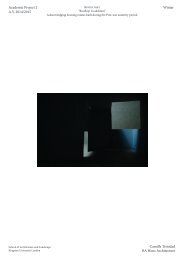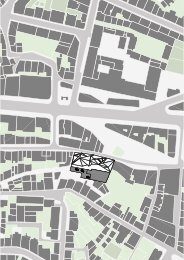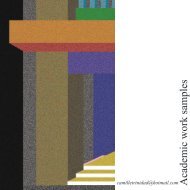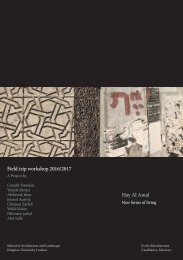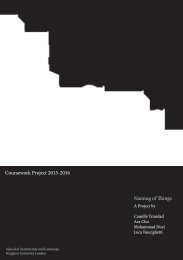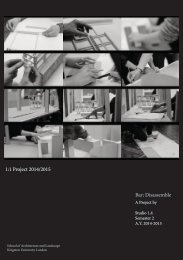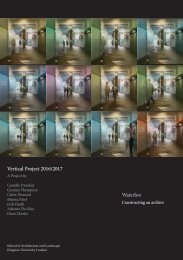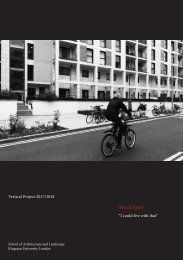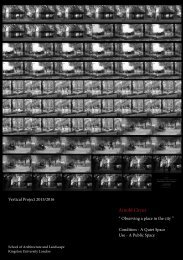National Theatre of the Philippines
My final year dissertation which explored a symbolic edifice in Manila, built by the National Artist for Architecture as per request of the former First Lady of the Philippines. It discusses Architecture's innate role in a political society, specifically in a country that has undergone centuries of colonialism; which got an overall grade of A.
My final year dissertation which explored a symbolic edifice in Manila, built by the National Artist for Architecture as per request of the former First Lady of the Philippines. It discusses Architecture's innate role in a political society, specifically in a country that has undergone centuries of colonialism; which got an overall grade of A.
You also want an ePaper? Increase the reach of your titles
YUMPU automatically turns print PDFs into web optimized ePapers that Google loves.
he would pass through <strong>the</strong> Art and Architecture building. As he was walking through <strong>the</strong><br />
Architecture department one day, he thought, “Maybe I’ll try one <strong>of</strong> <strong>the</strong>se courses!” So<br />
he signed up for an Architecture course. The moment he became involved in<br />
architecture, he discovered that he was unbelievably good at it.’ 2<br />
He attended University <strong>of</strong> Santo Thomas in which during <strong>the</strong> 50’s looked up to<br />
Industrial design, Modernism and <strong>the</strong> 20th century architects like Frank Lloyd Wright,<br />
Le Corbusier and Mies van der Rohe. 3 Not only with academia but during <strong>the</strong> post war<br />
period, <strong>the</strong> Philippine government set a particular task to local architects to create a<br />
master plan for <strong>the</strong> capital city <strong>of</strong> Manila and study American Modernism - having<br />
‘form follows function’ as a principle in which <strong>the</strong>y loosely base <strong>the</strong>ir design; and Latin<br />
American architecture – where <strong>the</strong>y focus on climatic and technical characteristics that<br />
led to <strong>the</strong> use <strong>of</strong> staple design elements such as sun shades, overhang, etc.<br />
4<br />
which are<br />
sensible to use considering <strong>the</strong> similarity to <strong>Philippines</strong>’ tropical climate and<br />
environment.<br />
As a young architect, Locsin’s break was a rare and incredible opportunity. A prominent<br />
family asked Locsin to design a circular chapel. Unfortunately, <strong>the</strong> client, Frederick<br />
Ossorio left for <strong>the</strong> United States for good; so <strong>the</strong> chapel was never built. But not long<br />
until Locsin received a project from <strong>the</strong> Catholic chaplain <strong>of</strong> a state university where he<br />
was asked to build ‘an open sided chapel seating one thousand that would be receptive<br />
<strong>of</strong> whatever faith’<br />
5. This time, <strong>the</strong> client is a priest who is ‘open-minded and completely<br />
unbound by tradition’ 6. With <strong>the</strong> consent <strong>of</strong> Mr. Ossorio, he developed <strong>the</strong> original<br />
scheme <strong>of</strong> his first commission which was never realised. The result is <strong>the</strong> Chapel <strong>of</strong> <strong>the</strong><br />
Holy Sacrifice. Nicholas Polites described it in his book as ‘modified design specified a<br />
thin-shell concrete dome that could span a large space at minimal cost’<br />
7. It was a<br />
triumphant construction and <strong>the</strong> chapel became an overnight sensation.<br />
2 Succeeding Success: Lindy and Andy Locsin, 2017 http://bluprint.ph/succeeding-success-lindy-and-andy-locsin/ (accessed 18 December 2017)<br />
3 Nicholas Polites, Akio Kawasumi. The Architecture <strong>of</strong> Leandro Locsin. New York: Wea<strong>the</strong>rhill, 1977<br />
4 Ábalos, Iñaki. Latin American Architecture Today, Harvard Design Magazine No. 34 http://www.harvarddesignmagazine.org/issues/34/latin-american-architecture-today (accessed 18 December<br />
2017)<br />
5 Nicholas Polites, Akio Kawasumi. The Architecture <strong>of</strong> Leandro Locsin. New York: Wea<strong>the</strong>rhill, 1977<br />
6 Nicholas Polites, Akio Kawasumi. The Architecture <strong>of</strong> Leandro Locsin. New York: Wea<strong>the</strong>rhill, 1977<br />
7 Nicholas Polites, Akio Kawasumi. The Architecture <strong>of</strong> Leandro Locsin. New York: Wea<strong>the</strong>rhill, 1977<br />
!6




